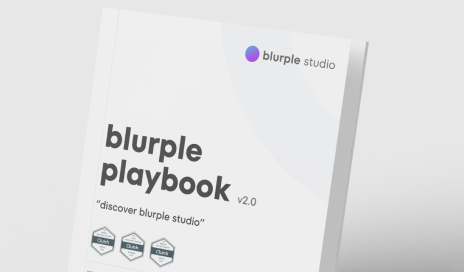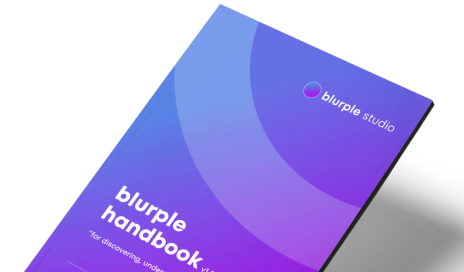This is Blurple Handbook
this is our universe, the recipe of principles & creativity.
Design Process & Principles
1. Figma as Our Core Tool
- Early Adopter: Blurple is among the early adopters providing feedback for new Figma features, leveraging its capabilities to enhance our workflows.
- Comprehensive Usage: We use Figma not only for UX/UI design but also for creating presentation documents, design principles, and system guidelines, ensuring everything is centralized.
2. Structured Design File Workflow
When we transition from research to the design phase, we work with three Figma files to ensure clarity and structure:
- Design File:
- This is the internal file where our design team creates and iterates on designs.
- It contains low-fidelity and high-fidelity wireframes, initial UI elements, and experiments.
- This file is not shared with the client and remains an internal workspace for the team.
- Showcase File:
- This file is used to share finalized design outputs with the client.
- Feedback is gathered through Figma comments or Coda, and the designs are iteratively updated until approved.
- It serves as the bridge between the internal design process and client collaboration.
- Hand-Off File:
- After the designs are approved, they are consolidated into this final file.
- The Hand-Off File includes grouped project screens organized as pages, along with the design system for seamless developer collaboration.
- Developers and clients can easily navigate this file to access finalized and documented design outputs.
3. Figma Pagination System
Within every design file, we organize pages for better clarity:
- Design Principle Page: Documents explaining the design principles established for the project.
- Design Output Pages: Organized folders containing UI outputs structured as pages, including:
- Colors
- Typography
- Grid & Spacing
- Iconography
- Components (e.g., Alerts, Buttons, Input Fields, Modals, Tabs, etc.)
4. Proactive Design Documentation
- Sticky Note-Based Documentation:
- Each screen in Figma includes FigJam sticky notes that provide concise explanations of the screen’s purpose and functionality.
- For complex projects, these notes are connected with arrows and visual guides for deeper clarity.
5. Principles That Guide Our Design Process
- Start with a Design System: Every project begins with the creation of a design system, ensuring consistency and scalability from the start.
- Research-Led Design: We never begin designing without a thorough understanding of user needs and data-driven insights.
- Component-Driven Approach: Designs leverage auto-layout and component structures, ensuring reusability and efficiency.
- Accessibility and Inclusivity: All designs comply with W3 accessibility standards, ensuring usability for diverse user groups.
- Testing and Validation: Iterative testing is conducted throughout the process, from wireframes to final UI designs.
6. Global User Testing Integration
We integrate advanced testing methods by partnering with a global user experience company to:
- Conduct user testing in over 55 countries, gathering rapid insights from diverse user groups within the same day.
- Validate wireframes and UI designs through targeted user tests, enabling iterative improvements.
7. Delivering for Scalability and Collaboration
- Embedded Design Systems: Design systems are embedded directly within project files to ensure updates and collaboration are seamless.
- Handoff for Development: Developers receive fully documented and organized design files, ensuring a smooth transition from design to implementation.








